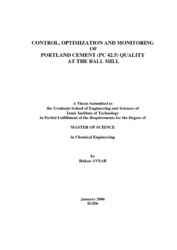Please use this identifier to cite or link to this item:
https://hdl.handle.net/11147/4007Full metadata record
| DC Field | Value | Language |
|---|---|---|
| dc.contributor.advisor | Doymaz, Fuat | en |
| dc.contributor.author | Avşar, Hakan | - |
| dc.date.accessioned | 2014-07-22T13:52:57Z | - |
| dc.date.available | 2014-07-22T13:52:57Z | - |
| dc.date.issued | 2006 | en |
| dc.identifier.uri | http://hdl.handle.net/11147/4007 | - |
| dc.description | Thesis (Master)--Izmir Institute of Technology, Chemical Engineering, Izmir, 2006 | en |
| dc.description | Includes bibliographical references (leaves: 77-78) | en |
| dc.description | Text in English; Abstract: Turkish and English | en |
| dc.description | xi, 89 leaves | en |
| dc.description.abstract | In this study, artificial neural networks (ANN) and fuzzy logic models were developed to model relationship among cement mill operational parameters. The response variable was weight percentage of product residue on 32-micrometer sieve (or fineness), while the input parameters were revolution percent, falofon percentage, and the elevator amperage (amps), which exhibits elevator charge to the separator. The process data collected from a local plant, Cimenta Cement Factory, in 2004, were used in model construction and testing. First, ANN (Artificial Neural Network) model was constructed. A feed forward network type with one input layer including 3 input parameters, two hidden layer, and one output layer including residue percentage on 32 micrometer sieve as an output parameter was constructed. After testing the model, it was detected that the model.s ability to predict the residue on 32-micrometer sieve (fineness) was successful (Correlation coefficient is 0.92). By detailed analysis of values of parameters of ANN model.s contour plots, Mamdani type fuzzy rule set in the fuzzy model on MatLAB was created. There were three parameters and three levels, and then there were third power of three (27) rules. In this study, we constructed mix of Z type, S type and gaussian type membership functions of the input parameters and response. By help of fuzzy toolbox of MatLAB, the residue percentage on 32-micrometer sieve (fineness) was predicted. Finally, It was found that the model had a correlation coefficient of 0.76. The utility of the ANN and fuzzy models created in this study was in the potential ability of the process engineers to control processing parameters to accomplish the desired cement fineness levels. In the second part of the study, a quantitative procedure for monitoring and evaluating cement milling process performance was described. Some control charts such as CUSUM (Cumulative Sum) and EWMA (Exponentially Weighted Moving Average) charts were used to monitor the cement fineness by using historical data. As a result, it is found that CUSUM and EWMA control charts can be easily used in the cement milling process monitoring in order to detect small shifts in 32-micrometer fineness, percentage by weight, in shorter sampling time interval. | en |
| dc.language.iso | en | en_US |
| dc.publisher | Izmir Institute of Technology | en |
| dc.rights | info:eu-repo/semantics/openAccess | en_US |
| dc.subject.lcc | TP883 .A94 2006 | en |
| dc.subject.lcsh | Portland cement | en |
| dc.title | Control, optimization and monitoring of Portland cement (Pc 42.5) quality at the ball mill | en_US |
| dc.type | Master Thesis | en_US |
| dc.institutionauthor | Avşar, Hakan | - |
| dc.department | Thesis (Master)--İzmir Institute of Technology, Chemical Engineering | en_US |
| dc.relation.publicationcategory | Tez | en_US |
| item.languageiso639-1 | en | - |
| item.fulltext | With Fulltext | - |
| item.openairecristype | http://purl.org/coar/resource_type/c_18cf | - |
| item.openairetype | Master Thesis | - |
| item.grantfulltext | open | - |
| item.cerifentitytype | Publications | - |
| Appears in Collections: | Master Degree / Yüksek Lisans Tezleri | |
Files in This Item:
| File | Description | Size | Format | |
|---|---|---|---|---|
| T000365.pdf | MasterThesis | 1.73 MB | Adobe PDF |  View/Open |
CORE Recommender
Page view(s)
142
checked on Jul 22, 2024
Download(s)
236
checked on Jul 22, 2024
Google ScholarTM
Check
Items in GCRIS Repository are protected by copyright, with all rights reserved, unless otherwise indicated.